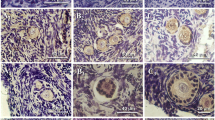Abstract
Purpose: Our purpose was to study the role of inhibin/activin during embryogenesis.
Methods: Transcripts of inhibin/activin subunits (α, β A , β B ), activin receptors (types I and II), and follistatin were detected by a reverse transcriptase–polymerase chain reaction in human reproductive cells and preembryos cultured alone or co-cultured with human endometrial cells.
Results: Transcripts of α, β A , β B subunits were all detected in granulosa luteal cells, but only β A units were detected in endometrial stromal and decidualized cells. In human preimplantation embryos, none of these subunits were detected in embryos from the four-cell to the morula stage and only β A subunits were detectable in blastocyst embryos. Activin receptors were detectable in all of the studied embryos and cells. Transcripts of β A , activin receptors, and follistatin were differentially expressed in human preimplantation embryos cultured in vitro and their expressions were significantly enhanced with the presence of endometrial stromal cells.
Conclusions: Our data suggest that there is a possible endometrium–embryo interaction via endometrial activins and preimplantation embryo receptors and that the embryonic expressions of these activins, their receptors, and binding proteins are dependent on embryonic stage.
Similar content being viewed by others
REFERENCES
Corrigan AZ, Bilezikjian LM, Carroll RS, Bald LN, Schmelzer CH, Fendly BM, Mason AJ, Chin WW, Schwall RH, Vale W: Evidence for an autocrine role of activin B within rat anterior pituitary cultures. Endocrinology 1991;128:1682-1684
Rivier J, Spiess J, McClintock R, Vaughan J, Vale W: Purification and partial characterization of inhibin from porcine follicular fluid. Biochem Biophys Res Commun 1985;133:120-127
Ling N, Ueno N, Ying SY, Esch F, Shimasaki S, Hotta M, Crevas P, Guillemin R: Inhibins and activins. Vitamins Horm 1988;44:1-46
Rabinovici J, Spencer SJ, Jaffe RB: Recombinant human activin-A promotes proliferation of human luteinized preovulatory granulosa cells in vitro. J Clin Endocrinol Metab 1990;71:1396-1398
Gonzalez-Manchon C, Vale W: Activin A, inhibin and transforming growth factor-β modulate growth of two gonadal cell lines. Endocrinology 1989;125:1666-1672
Katayama T, Shiota K, Takahashi M: Activin A increases the number of follicle-stimulating hormone cells in anterior pituitary cultures. Mol Cell Endocrinol 1990;69:179-185
Massague J: Receptors for the TGF-β family. Cell 1992;69:1067
Itoh M, Igarashi M, Yamada K, Hasegawa Y, Seki M, Eto Y, Shibai H: Activin A stimulates meiotic maturation of rat oocyte in vitro. Biochem Biophys Res Commun 1990;166:1479-1484
Carroll RS, Corrigan AZ, Gharib SD, Vale W Chin WW: Inhibin, activin, and follistatin: Regulation of follicle-stimulating hormone messenger ribonucleic acid levels. Mol Endocrinol 1989;3:1969-1976
Shimonaka M, Inouye S, Shimasaki S, Ling N: Follistatin binds to both activin and inhibin through the common subunit. Endocrinology 1991;128:3313-3315
Kimmelman D, Christian JL, Moon RT: Synergistic principles of development: Overlapping patterning system in Xenopus mesoderm induction. Development 1992;116:1-9
Beddington RSP, Smith JC: Control of vertebrate gastrulation: Inducing signals and responding genes. Curr Opin Genet Dev 1993;3:655-661
Albano RM, Arkell R, Beddington RSP, Smith JC: Expression of inhibin subunits and follistatin during postimplantation mouse development: Decidual expression of activin and expression of follistatin in primative streak, somites and hindbrain. Development 1994;120:803-813
Eramaa Marja, Heikinheimo K, Tuuri T, Hilden K, Ritvos O: Inhibin/activin subunit mRNA expression in human granulosaluteal cells. Mol Cell Endocrinol 1993;92:R15-R20
Seifer DB, Lambert-Messerlian G, Hogan JW, Gardiner AC, Blazer AS, Berk CA: Day 3 serum inhibin-B is predictive of assisted reproductive technologies outcome. Fertil Steril 1997;71(1):110-114
Liu HC, He ZY, Mele C, Damario M, Davis O, Rosenwaks Z: Hormonal regulation of expression of messenger RNA encoding insulin-like growth factor binding proteins in human endometrial stromal cells cultured in vitro. Mol Hum Reprod 1997;3:21-26
Polan ML, Seu D, Tarlatzis B: Human chorionic gonadotropin stimulation of estradiol production and androgen antagonism of gonadotropin-stimulated responses in cultured human granulosa-luteal cells. J Clin Endocrinol Metab 1986;62:628-633
Liu HC, He ZY, Tang YX, Mele CA, Veeck LL, Davis O, Rosenwaks Z: Simultaneous detection of multiple gene expression in mouse and human individual preimplantation embryos. Fertil Steril 1997;67(4):733-741
Manova K, Paynton BV, Bachvarova RF: Expression of activins and TGFβ1 and β2 RNAs in early postimplantation mouse embryos and uterine decidua. Mech Dev 1992;36:141-152
Feijen A, Goumans MJ, van den Eijnden-van Raaij JM: Expression of activin subunits, activin receptors and follistatin in postimplantation mouse embryos suggests specific developmental functions for different activins. Development 1994;120:3621-3637
Liu HC, Mele CA, Noyes N, Rosenwaks Z: Endometrial secretory proteins enhance early embryo development. J Assist Reprod Genet 1994;11:217-214
Liu HC, He ZY, Mele CA, Barmat L, Veeck L, Davis O, Rosenwaks Z: Human endometrial stromal cells improve embryo quality by enhancing the expression of IGFs and their receptors in cocultured human preimplantation embryos. In Program of the 10th Congress on In Vitro Fertilization and Assisted Reproduction, Vancouver, B.C., 1997, Abstract
Liu HC, He ZY, Mele CA, Veeck LL, Davis OK, Rosenwaks Z: Expression of IGFs and their receptors is a potential marker for embryo quality. Am J Reprod Immunol 1997;38:237-245
van den Eijnden-van Raaij AJM, Feijen A, Lawson KA, Mummery CL: Differential expression of inhibin subunits and follistatin but not of activin receptor type II. during early murine embryonic development. Development 1992;154:356-365
Albano RM, Groome N, Smith JC: Activins are expressed in preimplantation mouse embryos and in ES and EC cells and are regulated on their differentiation. Development 1993;117:711-723
Author information
Authors and Affiliations
Rights and permissions
About this article
Cite this article
He, ZY., Liu, HC., Mele, C.A. et al. Expression of Inhibin/Activin Subunits and Their Receptors and Binding Proteins in Human Preimplantation Embryos. J Assist Reprod Genet 16, 73–80 (1999). https://doi.org/10.1023/A:1022564722353
Issue Date:
DOI: https://doi.org/10.1023/A:1022564722353




